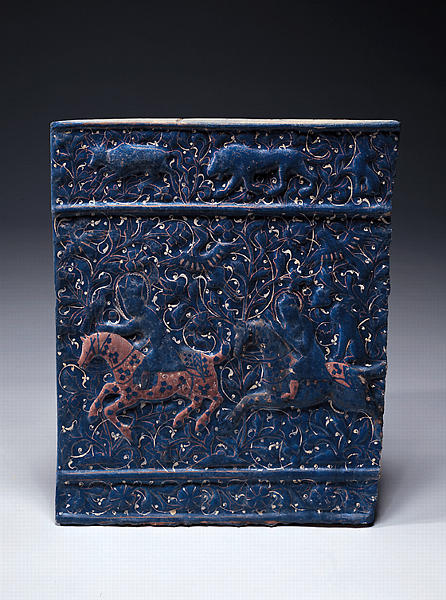Tile with Horsemen
- Iran
- Il-Khanid period
- 13c
- Fritware, molded, overglaze, painted
- H-52.2 W-44.5
Catalogue Entry
Beginning in the thirteenth century, tile revetment served as a colorful and luxurious sheathing for the interior of the most sumptuous buildings in Iran, which were typically constructed of baked brick. This monumental tile can be associated with the palace complex at Takht-i Sulayman, in northwestern Iran, built in the 1270s for a member of the Mongol or Il Khanid dynasty (1256\-1336). Excavations at Takht-i Sulayman demonstrate that areas of the complex were extensively and lavishly decorated with tiles in a variety of shapes and techniques, the latter including luster and lajvardina.1
Lajvardina, the type of ceramic ware to which the Shumei tile belongs, takes its name from the Persian word for lapis lazuli. Such wares were so designated in modern times because of their distinctive deep blue color (although some examples were produced in turquoise and in white).2 Following the Mongol invasions of the first half of the thirteenth century, this colorful, overglaze-painted technique developed from, and seems to have supplanted, mina'i ware (see cat. nos. 141\-44), which was not generally used for architectural decoration. This so-called lajvardina tile was molded, glazed blue, and fired. Gold leaf, of which very little is preserved here, was then applied (probably to much of the relief surface, now blue), followed by at least three different glazes: white, orange, and brown. A second firing fixed the glazes and kept the gold in place.3
The tile's molded relief decoration is divided into three bands: a wide central register and two narrow, unequal zones serving as borders. A pair of mounted huntsmen is shown galloping across the central field. A bird, probably a trained bird of prey, is perched on the wrist of the lead rider, while a large feline, perhaps a cheetah, sits behind the second rider, to whom it is secured by a leash. A trio of birds soars above the heads of the riders. The figures are set within a conceptualized landscape of tall, leafy, flowering plants. In the register above are three animals: a galloping bull, a lion (?), and a tall rabbit. The lower register is filled with floral rosettes alternating with curved, leafy branches. Here, as elsewhere, the relief decoration is set against scrolling and spiraling leaves, in white.
Tiles bearing the identical three bands of relief ornament, but decorated in the luster technique, were excavated at the Il Khanid palace at Takht-i Sulayman.4 Other closely related luster tiles showing pairs of mounted huntsmen, bordered by a band of three animals above and a field of rosettes and leafy branches below, were also found at this site, indicating that these tiles once formed part of an extensive frieze celebrating the hunt.5 Both the location of the palace at Takht-i Sulayman and its tile decoration may represent a conscious attempt on the part of the Il Khanids to associate themselves with the ancient tradition of Persian kingship. The palace complex was built on a site closely associated with the Sasanian dynasty, while a number of figural and epigraphic tiles excavated within the complex have to do with the Shah Nameh, the Iranian national epic, which recounts the tales of the pre-Islamic rulers of Iran.6 Tiles decorated with scenes of the hunt, including the Shumei tile, fit comfortably within this same milieu and likewise may have been inspired by epic literature.7
A pottery kiln and molds for tiles were discovered at Takht-i Sulayman, indicating that the tile decoration from the palace may have been produced locally.8 Although lajvardina frieze tiles of the type discussed here were not discovered at the site, the Shumei tile evidently was made in the same mold as the luster tiles found at Takht-i Sulayman, the only excavated Il Khanid palace. This tile may have come from a nearby structure or another palace that has not survived.9
LK
1. Naumann 1969; Naumann 1976.
2. The term lajvardina seems to occur first in a sixteenth-century copy of the well-known early fourteenth-century treatise on the manufacture of tiles and ceramic wares by Abu'l-Qasim, where it is confused with what is commonly called mina'i ware. See Allan 1973, pp. 114\-15, 120.
3. Technical analysis of the surface clearly indicates that the gold was applied before the white, orange, and brown glazes, not as the final phase, as lajvardina is often described. Visual evidence also suggests the gilding was applied earlier. More such information will appear in volume two of this catalogue. I am grateful to Pieter Meyers for this information.
4. I am grateful to Tomoko Masuya, of the National Museum of Ethnology, Osaka, for sharing with me a drawing of one of the luster frieze tiles found at Takht-i Sulayman. The reconstructed tile in this drawing is identical to the Shumei lajvardina tile except for the different surface decoration. Specific decorative details such as facial features, elements of costume, and horse trappings, depicted in luster on the tiles from Takht-i Sulayman suggest that the lajvardina tile originally carried such details in the gold leaf decoration, now lost.
5. E.g., Naumann 1969, fig. 6; Naumann 1976, pl. 8a.
6. Melikian-Chirvani 1991.
7. Scenes of the hunt and battle (also depicted in the tiles from Takht-i Sulayman) are typically included in illustrated texts of the Shah Nameh from the early fourteenth century onward. The hunt scene on the lajvardina and on the related luster tiles can be broadly compared to similar scenes from the earliest extant illustrated versions of the Shah Nameh from the early fourteenth century; see Simpson 1979, e.g., fig. 83.
8. Naumann 1976, pp. 63\-65.
9. Comparatively few of the tiles discovered at the site of the palace complex were found in situ; in fact, the palace seems to have been systematically plundered over a long period of time; one exception is the south octagonal pavilion, which permitted a reconstruction of the interior tile and stucco decoration; see Naumann 1969.
